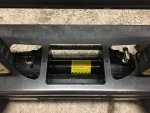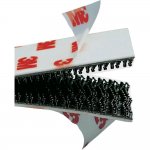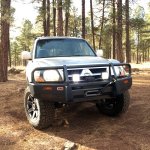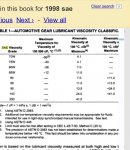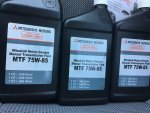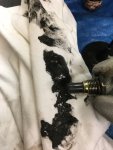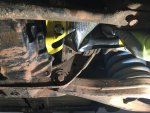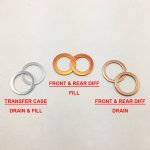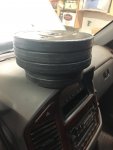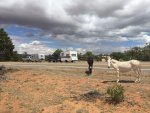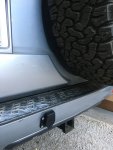SONICMASD
Adventurer
WINCH INSTALL CONTINUED...
So there are 4 ways to solve this Synthetic Rope + Hawse Fairlead vs ARB Bumper situation:
1. Cut about 1/4"-1/2" of metal off the bottom of the ARB bumper opening. - Nothing wrong with this option and it's free, but just in case I wanted to switch to a different fairlead one day or sell the bumper, I didn't want any possible issues down the road.
2. Drill new hole for the hawse fairlead bolts just above the existing bottom holes. - I didn't want to do this for fear of compromising the strength of the bumper's bottom winch mount. There would only be like 1/4-1/2" of metal in the existing hole and the new one so that kind of worried me. Though, Mr. Pajero himself down in Oz choose this solution and I'm sure it worked out fine:

3. Get a Roller Fairlead instead, you can even get plastic rollers which are supposed to work better with synthetic rope than the traditional steel ones. This would cost around $60 but I don't like the look or functionality of how far out the roller fairleads stick out on this bumper. I'm not sure if I'm going to keep the rubber bumpers on the front but without them a roller fairlead would be the farthest point out there and I could see myself scraping it on rocks, then having to replace rollers every time whereas a hawse fairlead is skinnier and sits deeper in the bumper.

4. Buy an offset hawse fairlead that is shaped like a trapezoid to fix this issue with many ARB bumper models. - This is what I chose to do. Slee Offoad makes one for $90 + shipping, Custom Splice makes one for $90 + shipping, Chinese ebay specials are like $40 (but they're like 1/2 the thickness which might be too low profile and on an angled pull your rope might be rubbing on the sides of the opening in the bumper, and Factor 55 makes one for like $120 shipped. I decided to go with Factor 55, mostly because they have a video detailing what goes into making their offset Hawse Fairlead and also because it was the only one I could get delivered within 2 days via Amazon Prime and I really wanted this install to be over after having struggled so much with the ARB bumper mounts and now hitting this 3rd snag in the winch install.
Now, this snag isn't Smittybilt's fault obviously, it's an ARB bumper thing. BUUUUUT many Australian winch companies have taken note of this given how popular ARB bumpers are down there and supply universal hawse fairleads with their winches that can bolt up to almost any bumper the right way. I know ARBs are way less popular in the USA but they're still a major brand that has been around for decades and are the go to for most Japanese 4x4s - so it'd be nice to see US winch mfgs start to take this into account.

Snag #4. As mentioned previously, the offset hawse fairlead should be thicker to help push the synthetic rope out far enough so that it can't rub on the edges of the ARB bumper's opening during an angled pull. This is why Factor 55, Custom Splice, and Slee all make their ARB offset fairlead 1.5" thick. Well, a thicker fairlead means that the mounting bolts that come with the Smittybilt winch are now going to be too short to work for the bottom 2 mounts.
You would think this wouldn't be very hard to buy 2 new bolts but they just happen to be a really weird combination of specs that are very hard to find, especially in a small town.
If I remember correctly, the stock ones from Smittybilt are M10x1.25 x35mm 10.9 grade with Zinc Coating. I could find M10x1.25 with extended length to 40 or 45mm no problem but not in a hi tensile strength grade 10.9. Then I did find them in the right grade but only in bare steel with no rust proofing. Finally, after striking out at Ace and Home Depot, I went to Copperstate Nut & Bolt and they set me up with their only option which was to switch to SAE: 3/8x1 3/4" (I think those were the measurements but am going off memory from a few weeks ago) Grade 8 Zinc Plated and the corresponding square nuts, plus high strength flat and lock washers. Cost about $5.
So there are 4 ways to solve this Synthetic Rope + Hawse Fairlead vs ARB Bumper situation:
1. Cut about 1/4"-1/2" of metal off the bottom of the ARB bumper opening. - Nothing wrong with this option and it's free, but just in case I wanted to switch to a different fairlead one day or sell the bumper, I didn't want any possible issues down the road.
2. Drill new hole for the hawse fairlead bolts just above the existing bottom holes. - I didn't want to do this for fear of compromising the strength of the bumper's bottom winch mount. There would only be like 1/4-1/2" of metal in the existing hole and the new one so that kind of worried me. Though, Mr. Pajero himself down in Oz choose this solution and I'm sure it worked out fine:

3. Get a Roller Fairlead instead, you can even get plastic rollers which are supposed to work better with synthetic rope than the traditional steel ones. This would cost around $60 but I don't like the look or functionality of how far out the roller fairleads stick out on this bumper. I'm not sure if I'm going to keep the rubber bumpers on the front but without them a roller fairlead would be the farthest point out there and I could see myself scraping it on rocks, then having to replace rollers every time whereas a hawse fairlead is skinnier and sits deeper in the bumper.

4. Buy an offset hawse fairlead that is shaped like a trapezoid to fix this issue with many ARB bumper models. - This is what I chose to do. Slee Offoad makes one for $90 + shipping, Custom Splice makes one for $90 + shipping, Chinese ebay specials are like $40 (but they're like 1/2 the thickness which might be too low profile and on an angled pull your rope might be rubbing on the sides of the opening in the bumper, and Factor 55 makes one for like $120 shipped. I decided to go with Factor 55, mostly because they have a video detailing what goes into making their offset Hawse Fairlead and also because it was the only one I could get delivered within 2 days via Amazon Prime and I really wanted this install to be over after having struggled so much with the ARB bumper mounts and now hitting this 3rd snag in the winch install.
Now, this snag isn't Smittybilt's fault obviously, it's an ARB bumper thing. BUUUUUT many Australian winch companies have taken note of this given how popular ARB bumpers are down there and supply universal hawse fairleads with their winches that can bolt up to almost any bumper the right way. I know ARBs are way less popular in the USA but they're still a major brand that has been around for decades and are the go to for most Japanese 4x4s - so it'd be nice to see US winch mfgs start to take this into account.

Snag #4. As mentioned previously, the offset hawse fairlead should be thicker to help push the synthetic rope out far enough so that it can't rub on the edges of the ARB bumper's opening during an angled pull. This is why Factor 55, Custom Splice, and Slee all make their ARB offset fairlead 1.5" thick. Well, a thicker fairlead means that the mounting bolts that come with the Smittybilt winch are now going to be too short to work for the bottom 2 mounts.
You would think this wouldn't be very hard to buy 2 new bolts but they just happen to be a really weird combination of specs that are very hard to find, especially in a small town.
If I remember correctly, the stock ones from Smittybilt are M10x1.25 x35mm 10.9 grade with Zinc Coating. I could find M10x1.25 with extended length to 40 or 45mm no problem but not in a hi tensile strength grade 10.9. Then I did find them in the right grade but only in bare steel with no rust proofing. Finally, after striking out at Ace and Home Depot, I went to Copperstate Nut & Bolt and they set me up with their only option which was to switch to SAE: 3/8x1 3/4" (I think those were the measurements but am going off memory from a few weeks ago) Grade 8 Zinc Plated and the corresponding square nuts, plus high strength flat and lock washers. Cost about $5.
Last edited:









